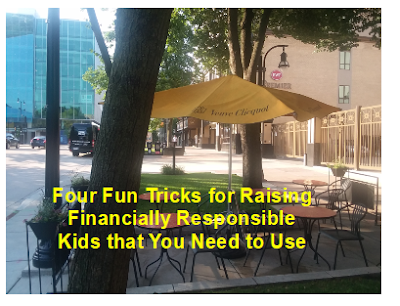Guest Post: Raising Financially Responsible Kids
Hi everyone! We sincerely hope that you've had a very Merry Christmas with your families. This week at Parenting on Pennies, we have a guest post from Joseph Sheeley. He is providing tips for raising financially responsible kids. Thank you, Joseph for such a great post!
P.S. Next week will be the obligatory "setting new goals for a new year" post. Stay tuned!
By Joseph Sheeley
(a.k.a. SmallIvy)
Good money habits
are critical for future economic success.
You could hand someone with bad habits $100,000 and it would be gone in
a matter of months. You could turn
someone with good money habits loose with $1000 for rent for a few months and
they'd never need any help ever again.
Unfortunately, many children never learn to handle money well. Perhaps this is because finances are a taboo
topics in a family, right up there with where their siblings came from, so many
young adults enter the world with very little understanding of how to handle
money.
But teaching
basic finance skills to your children needs not be difficult. We started early with our children and as a
result they have a better understanding of finances than many adults. Here are a few tricks that we used to
introduce our kids to important money concepts that you can use with your own
children:
1. Dollar
Drinks
Any parent knows
that kids will tend to automatically order a soft drink when they sit down at a
restaurant. This habit will often carry
with them into adulthood where they have a Coke or a glass of wine with every meal. While there is nothing wrong with the
occasional beverage to enhance a meal, soft drinks add $3 per person to the bill
at many restaurants and even a beer can run $6 or more.
Often kids will
just take a sip or two of their drink during the meal, making that drink cost
about $1 per sip. Even as adults, you'll
often find that if the food comes reasonably quickly, you'll barely touch your
non-alcoholic drink. Because alcoholic
drinks cost more, adults will at least tend to finish them, but add a couple of
glasses of wine or mixed-drinks and you'll be paying as much for drinks as for
your meal. You'll also be adding 500 to
1000 calories, which most adults really don't need.
Just making the
switch to water will save you a lot of money, plus reduce calories and improve
your health. If you can learn this habit
young and carry it with you into adulthood, it will pay off big over your lifetime. This can be a tough sale for a child who is
used to a soft drink or juice at every meal, however. That is until you add a
small financial incentive.

We started giving
our children $1 each time they ordered a water instead of a soft drink at a
restaurant. Not only did this save us $1
to $2 per child per meal for kids drinks, but it also taught our children to
think about whether a purchase was worth the price before they made it. When the drink seemed to have no cost, since
they were not footing the bill, they would automatically order a drink when
they sat down whether they really wanted it or not. Once the cost of the drink became their
money, they started choosing whether or not to spend the money rather than just
going on autopilot.
Once they
realized that they could have a small toy or something else they wanted instead
of having the drink, we found that they really didn't get drinks that
often. Suddenly both children were
ordering waters at all of their meals unless they really wanted a soft
drink. Normally we only go out once per
week, but my son actually realized when we were on a long vacation where we
were eating all of our meals out that he could make $20 or $30 during the
course of the trip by getting waters. In
addition to incentivizing him to be judicious in his purchases, this saved us
between $20 and $60 during the course of the trip in drink costs, which was
enough to cover several kids-meals.
Win-win!
2. Put Them on Commission
Many children
have a set of chores that they are expected to do. They are then either given an allowance to
buy the things they want or their parents just buy the things that they want
after a suitable period of negotiations.
Many parents think that having their children do chores teaches responsibility
and the need to do things for the family, but often it just teaches their
children that work is undesirable and to do as little as is needed to meet the
bare minimum requirements. In a job or
entrepreneurial environment it is the people who go above and beyond and think
of ways to meet the needs of their customers better that do the best.
Likewise, many
parents think that providing their children with an allowance will teach them
how to handle money since now they'll be choosing what to spend it on. But because they receive the same amount of
money regardless of how much work they do, rather than linking their income to
their output, children learn that they deserve to be paid just because they
breathe air. If no allowance is given
and things are just bought when a child asks, they don't learn to assign a
value to things at all. Because they
didn't need to put work into acquiring the money to purchase their items, they
may not take care of them and may not be careful with their selections. Money just seems like a limitless thing.

"Our children tend to be highly motivated to do chores."
While we do have
tasks that our children are expected to do gratis as a member of the household, we also started providing tasks that
our children could do for a commission.
This started when they were very young with a quarter for replacing the
bag in the trash cans and grew into larger amounts for larger tasks like $3 to
put the dishes in the dishwasher away or even $15 to mow the front lawn.
Note that we do
not underpay our children for the tasks they complete as some parents tend to
do since this would be a demotivator and, frankly, unfair. If we would need to pay a maid $50 to clean
the house, we would pay our children $6 to sweep and mop a kitchen floor. If it would cost us $10 to have our car
washed, we pay $10.
This system has
created some interesting results. These
are:
* Our children tend to be highly motivated to do
chores. Our son has the nightly task of cleaning out the
three cat litter-boxes we have (why we have so many cats is another
story). He does this without being asked
and does an excellent job. At times our
kids get on a kick about earning money and will ask us for additional tasks to
do, seeing how much they can earn. They
have learned that they can make more by figuring out what needs to be done and
doing more, which is exactly the attitude to have when they get out into the
workforce.
* We've had labor strikes. One issue we
do have is that sometimes our children will have made so much money and have
nothing they really want to buy. It is
really interesting how similar this is to people in manual labor jobs who tend
to work when they need money and then not show up to work when they have enough
cash to meet their needs. While this may
satisfy their immediate needs, this is obviously not the way to advance in the
workforce or run a successful company.
At these times they may not want to do the tasks, even if we really need
to have these tasks done. At these times
we've explained to our children that when you have a job you need to continue
to work even when you don't need money right now because otherwise you'll lose
that job and you won't have the work available when you do need money.

* We've seen the detrimental effects of unneeded
charity. Early on when our son had just started to do tasks
for commission, putting the trash bags in the can for a quarter and earning
maybe fifty cents per week, his grandfather gave him $20 for a trip we were
taking. Getting this large sum of money
made him not want to keep doing his task for a measly quarter. Once again we explained to him that he still
needed to do his work even if he didn't need the money right now.
3. Bank of MAD
In addition to
putting our kids on commission, we also formed the Bank of Mom and Dad, known
familiarly as the “Bank of MAD.” This
bank pays an interest rate of 5%, compounded whenever we remember to calculate
interest. (And no, we are not taking any
new deposits except from existing customers.)
Each child has a passport book and a checkbook with a few checks. This is to have them start learning about
saving money and how banking works.
One thing that
was truly surprising with the Bank of MAD is how much money the kids
deposit. Instead of spending every
dollar as it comes to them, they often make deposits, letting it build up until
they decide to buy something fairly large.
One item my son purchased when he was about 10 was an iPod, which seemed
fine until he decided to walk into the lake with it in his pocket. It was about then that I decided that the
only thing a kid should own that cost more than about $100 was a bicycle or
something else equally sturdy.

"..this is exactly what businesses and banks are doing in the real economy."
Having both the
commission system and the Bank of MAD has had some interesting results and
actually helped me understand economics a little better. We keep some cash in a drawer for chores. At first we would pay our children, then they
would come back every so often and make a deposit in the bank, at which point
we would put their cash back in the drawer.
Eventually they just started putting their pay into the bank without
handling cash at all some of the time.
When they wanted to buy something, we would then typically use our debit
card and then deduct the purchase price from their bank accounts.
What was
interesting was to see the cash go out to them for pay, and then come right back
and be put into the drawer when they made a deposit. When they did something else, the same bills
would come out and be used to pay them again.
This made me realize that is exactly what businesses and banks are doing
in the real economy: When you earn
money, you are paid but then some of that money is put back into the bank. They therefore get to keep making use of the
money until you actually spend it somehow.
Of course,
sibling rivalry affected the Bank of MAD system. My son, who is three years older than my
daughter, told her when she was about six that the money she was putting into
the account was going to him. He even
called the money he was receiving, “Amy money,” in reference to her. Since she saw the bills that she was
depositing going out to him as he did tasks, she assumed it was true. He had her in tears and we had to explain to
her that she still had the money in the account and could retrieve it whenever
she wanted and that the actual bills did not matter. Maybe this was a good lesson for her in how
banking worked, or just how devious big brothers can be.
4. MAD Brokerage
Because we wanted our children to learn about investing,
in addition to the Bank of MAD, we also have the MAD brokerage. One issue with trying to have children buy
stocks with a traditional brokerage firm “for real” is that they have very
little money to invest. If the minimum
brokerage fee is $10 and they're buying one share of stock for $50, they would
end up paying about a 20% commission – not good. In addition, we'd need to keep track of stock
certificates since they would have difficulty opening a brokerage account with
such a small amount of money.
Using the MAD brokerage, the kids can invest their money
and buy any of the stocks we hold in our regular investment accounts. We just note down in a separate passbook (and
in a spreadsheet on the computer) when they bought the shares and how much they
paid. They can then track their
investments and see how well they are doing.
In the future they can let us know when they want to sell shares and we
can just put the money in their Bank of MAD accounts, or give them cash, as appropriate. In this way they get the experience of
investing without needing to pay brokerage commissions. We typically use the stock price at the close
of trading the day they make the order as the price they pay or receive. Alternatively, you could allow them to invest
in some of the mutual funds you own instead of individual stocks.

Note that we choose to use investments that we already
own, both to save them the trouble of picking stocks from the whole market and
to protect ourselves in case the stocks they buy do really, really well. You could allow them to choose any stock in
the market, but you run the risk of needing to find some serious cash should
they hit a grand slam. Realize also that
you might need to sell some shares to pay them if you do not have enough cash
lying around, especially if they cash out all at once when they are going to
college or something. You could also set
up a brokerage for them at that point and actually transfer the shares to
them. If you do, whatever price you paid
for the shares will go with them, however, so you could be sticking them with a
tax burden if the shares were already highly appreciated when they bought them.
Note also that you do need to pay attention to gift tax
rules if you start your own MAD brokerage house. Since they are not actually buying shares of
stock, instead just tracking how your shares do and then you are giving them
cash when they sell, any gain that they make is a gift that you and your spouse
are making to them. Currently gift taxes
are at about $12,500 per person, or $25,000 for a married couple, so this will
probably not be an issue. Be mindful of
the limits, however, if you discover that you are parent to the next Warren
Buffett and they start talking about company moats and such.
Joseph Sheeley writes
under the pseudonym SmallIvy on The Small Investor, a blog dedicated to personal finance and
investing. A rocket scientist by day, he
has been investing since the age of 12 and has portfolios for more than
thirty-five years. He is the author of
the book, The SmallIvy Book of Investing, Book 1: Investing to Grow
Wealthy and FIREd by Fifty, a book on budgeting and cash flow management.


Comments
Post a Comment